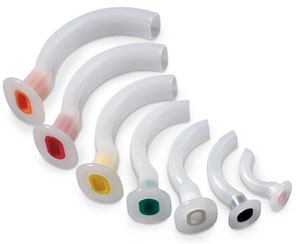A fundamental responsibility of the anaesthesia provider is to maintain a patent airway. The purpose of an airway is to lift the tongue and epiglottis away from the posterior pharyngeal wall and prevent them from obstructing the space above the larynx. An oral or nasal airway decreases the work of breathing during spontaneous breathing using a face mask.

Types
Oropharyngeal Airways
The airway follows the curvature of the tongue, pulling it and the epiglottis away from the posterior pharyngeal wall and providing a channel for air passage.
Made of elastomeric material or plastic.
Oral airways have not been associated with an increased incidence of sore throat or other symptoms or bacteremia
It has a flange at the buccal end to prevent it from moving deeper into the mouth. The flange may also serve as a means to fix the airway in place.
The bite portion is straight and fits between the teeth or gums.
The pharyngeal end rests between the posterior wall of the pharynx and the base of the tongue and, by exerting pressure along the base of the tongue, also pulls the epiglottis forward.
Guedel Airway
The Guedel airway has a large flange, a reinforced bite portion, and a tubular channel.
Non traumatic,available in sizes 1,2,3,4,5.
disadvantages- thick secretion block rubber airway easily,they may not prevent bitting of ETT, with repeted sterlisation rubber becom soft.
Berman Airway
➤ The Berman airway has a center support and open sides.
➤ The center support may have openings. There is a flange at the buccal end.
➤ The side opening can be opened wider to engage or disengage a tracheal tube.
Patil-Syracuse Endoscopic Airway
➤ Designed to aid fiberoptic intubation. It is made from aluminum.
➤ It has lateral channels and a central groove on the lingual surface to allow a fiberscope with a tracheal tube to pass.
➤ The airway must be removed from the oropharynx before a tracheal tube can be advanced over the fiberscope and into the glottis.
Williams Airway Intubator
➤ Designed for blind orotracheal intubations and also used to aid fiberoptic intubations or as an oral airway.
➤ The proximal half is cylindrical, while the distal half is open on its lingual surface. Williams airway intubator provided a better view of the glottis in a significant number of patients
Ovassapian Fiberoptic Intubating Airway
Designed to deliver a fiberscope as close to the larynx as possible
It has a flat lingual surface that gradually widens at the distal end. At the buccal end are two vertical sidewalls. Between the sidewalls is a pair of guide walls that curve toward each other. The guide walls are flexible and permit the airway to be removed from around the tracheal tube.
The proximal half is tubular so that it can function as a bite block. The distal half is open posteriorly.
Uses:
➤ To maintain an open airway.
➤ To prevent a patient from biting and occluding an oral tracheal tube.
➤ Protect the tongue from biting.
➤ Facilitate oropharyngeal suctioning, to obtain a better mask fit.
And provide a pathway for inserting devices into the esophagus or pharynx.
Disadvantages may not be tolerated in lighter plane of anesthesia- induses coughing, gag reflex, laryngospasm, bronchospasm, vomiting.